December 22, 2023
The Gainesville Regional Utilities Authority and the City of Gainesville are coming to a crossroads in January. It’s an early decision that will dictate a lot of what comes after.
In January, tentatively scheduled for January 3rd at 5:30, the Gainesville Regional Utilities Authority will decide whether to further cut the $15.3 transfer that was reduced $19 million last year. If that happens it will mean another budget crisis for the City of Gainesville, one that we will be working on for the next year, and will be reeling from for years afterward.
But it won’t just be bad for the government of Gainesville, it will be bad for everyone. It will mean less services for you, potentially higher taxes, with little hope of seeing your GRU bills come down in any real way. Perhaps most of all it will be bad for GRU itself.
The devastating impacts of another GFT reduction
Last week the City Manager put out a memo letting the Commission know what cuts like these will mean. I don’t think I could do a better job of explaining it than she did.
Make no mistake, the FY 2025 budget development process will be more difficult, as most Departments have already reduced operational expenses and a large number of vacant positions have already been eliminated. The decisions made by the City Commission to balance the FY 2024 Budget were also difficult and seriously impacted General Government operations and staff. The FY 2024 Adopted Budget eliminated 125.5 fulltime equivalent positions – reducing expenditures by $8.3 million. Further, 13 out of 20 General Government funded departments had their operating budgets reduced in an effort to prioritize public safety services. All department operations, including public safety, must be evaluated in FY 2025.
Last year we reduced revenues by $19 million to give that money to GRU to help pay down its debt faster. The result was about half of that cut came from taxes and half came from cutting government. It was far and away the biggest budget cut in our city’s history, three-times the cuts we had to make during the 2009 recession.
As the manager states though, this year will be worse. Last years $8.3 million of cuts got rid of the “wiggle room” the City had, plus eliminated a lot of programs and people that were critical to the city. These were primarily from operations and administration instead of community facing cuts. The easy decisions are behind us, ahead is much more pain.
To put a cut of this magnitude into perspective, I plugged in numbers showing what an even, across-the-board $15.3 million cut evenly distributed across all departments looks like. This comes out to essentially a 10% cut to all departments. Here’s how that comes out (1):
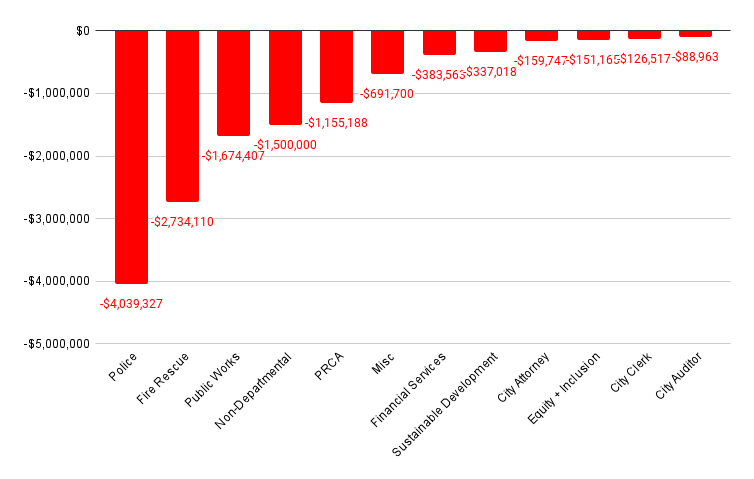
A loss of police or fire rescue will mean less patrols, which could mean higher crime. It will mean longer response times during emergencies. A cut to public works will mean less maintenance, so an increased risk of flooding, worse roads, and less safe streets. A cut to Cultural Affairs will mean the ending of beloved city events. Whether that means the end of the Christmas lighting at the Thomas Center, Free Fridays, or the Medieval Faire we don’t know, but it will mean tough decisions like that. A cut to non-departmental budgets means cutting GRACE Marketplace, which means less beds for homeless people, which means more homeless people on the streets.
Alternatively, it could mean higher taxes, right on the heels of last years tax increase. Rapid tax increases like this are hard for residents and businesses to bear, and will mean higher rents and more businesses struggling to survive.
There are no easy cuts this time around
There seems to be a feeling among some conservative critics of the City of Gainesville that there is a line item called “pet projects” that can be cut and will magically save the City millions of dollars. Where this line item is and how much is allocated to it is very elusive, but some people seem to believe it fervently.
The truth is the City of Gainesville does very little outside of core services, and the things we do are modest projects that are far from personal pet projects, they are beloved community projects that have survived both Republican and Democratic majorities on the Gainesville City Commission. These are events like the Medieval Faire, amenities like GRACE Marketplace, or Gainesville Fire Rescue’s “Community Resource Paramedicine” program.
To be fair to these misleading critics, they have been lied to by politicians for decades. The most egregious was Keith Perry’s 2018 election, in which he and the Republican Party of Florida spent millions on ads calling to “hold GRU accountable” for high rates used to pay for an ice skating rink.
There was, of course, no ice skating rink, building one was never even considered by the City Commission, much less using GRU funds. That just goes to show how untethered from reality these attacks on GRU have been. It’s not limited to Sen. Perry either. Most recently Ed Bielarski ran a campaign based on similar talking points, despite spending years opposing those same points when he was GRU General Manager.
But the reality is that there are no “pet projects” in our city budgets. Police and Firefighters make up over half of our city budget. After that is public works, which paves roads, builds sidewalks, and ensures we have working infrastructure for the future. Following that is Parks, Recreation & Cultural Affairs, which upkeep our local parks and puts on events. After that is paying off our pension obligations in the “non-departmental” funds, which we can’t cut. What’s left over is simply the administration of those functions: an internal auditor, human resources, facilities, etc.(2). Administration already got cut severely last year, so there’s not much more slack there.
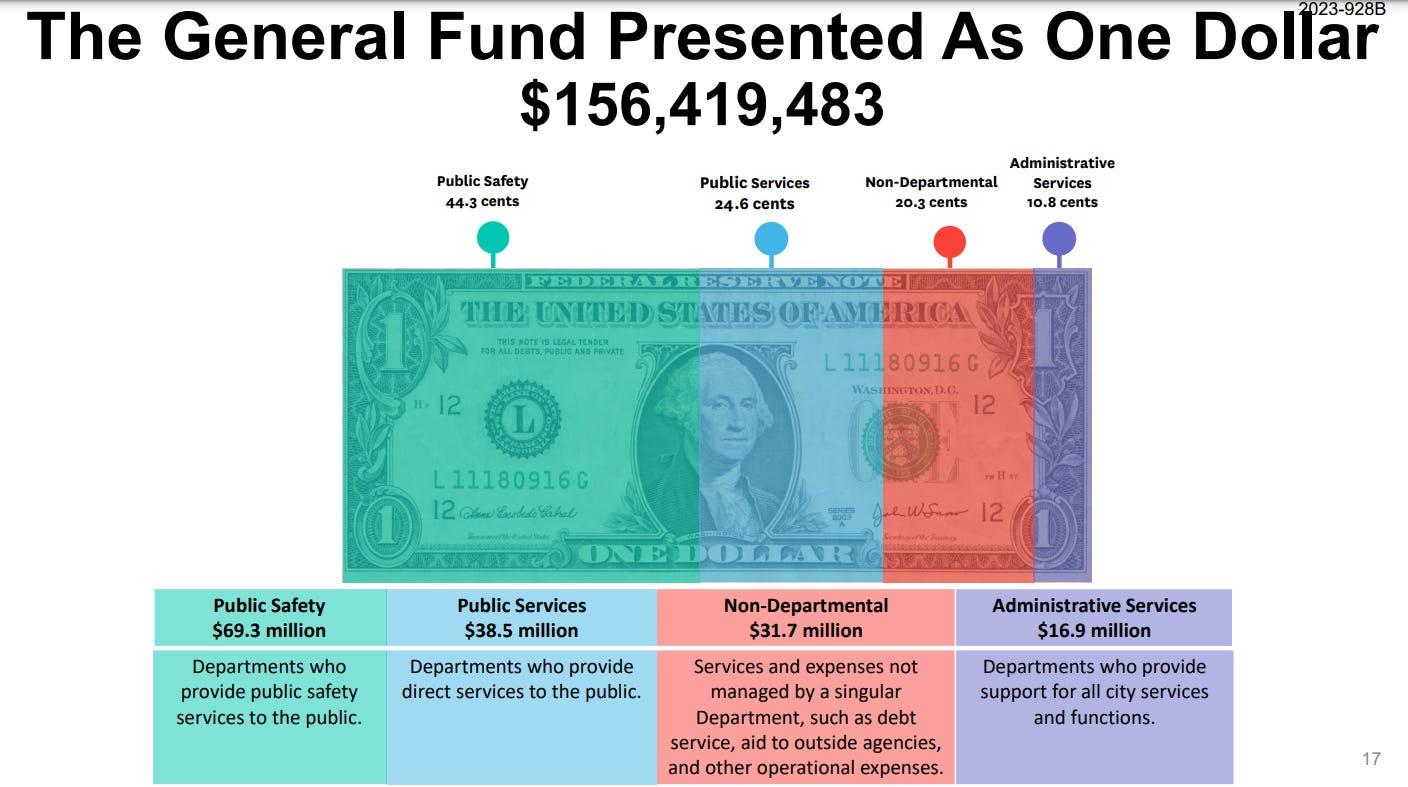
And like everything else the price of these things is going up exponentially right now. In a time when the City is cutting, the cost to hire a worker, to pave a road, or fix a building is exploding. That means even at a flat budget we are still forced to do less, which means cutting.
The incredible deal GRU Is getting
If I were on the GRU Authority, which I obviously am not, my first act on the board would be to send a big “thank you” card to the residents of the City, thanking them for the huge giveaway they just gifted us.
I’m not holding my breath, but it seems like the reasonable thing to do. Last year, as GRU debt became a political hot-button issue in Tallahassee, General Government agreed to cut budgets by the largest amount in history to help GRU shore up their budget. The Commission agreed with this decision even though we knew GRU would be passed to a governor-appointed board. We did it in good faith, because we believed it was the right thing to do. Thanks to our city agreeing to give them $19 million per year for 10 years, GRU is set to make $31 million in profits this year (3).
By comparison, GRU agreed to cut $3.4 million a year, a 5-to-1 difference between these portions of our city government.
Today the transfer stands at a mere $15.3 million, the lowest it’s been in over 30 years, even as inflation has made our dollar less than half what it was then. According to GRU’s numbers released at the December 6 GRU Authority meeting, it is the lowest transfer of any energy-producing utility in the state by a very large margin.
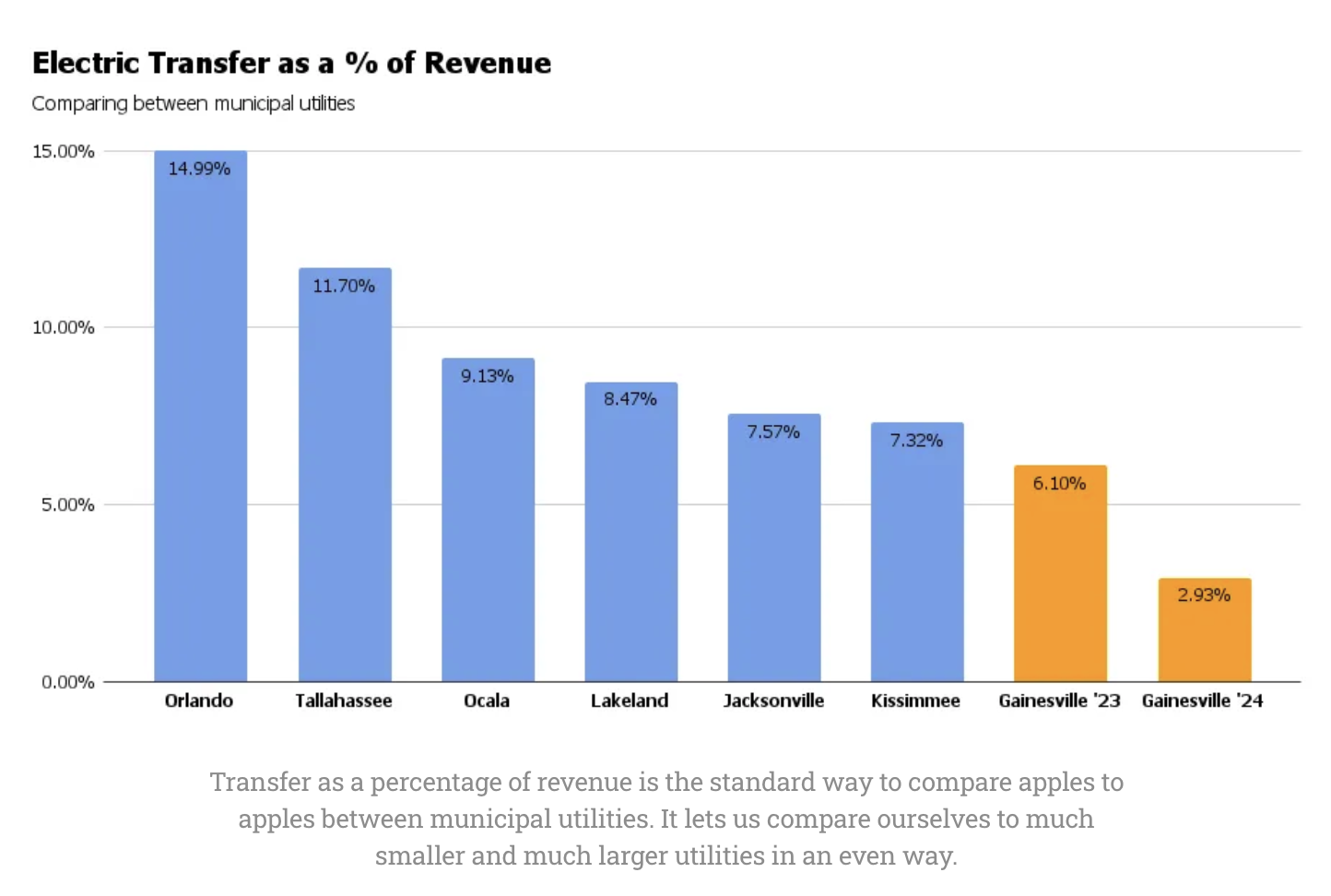
Today GRU electric is paying, as a percentage of its revenue, 1/5 of Orlando’s utility, 1/4 of Tallahassee’s, 1/3 of Lakeland’s, and 1/2 of Jacksonville’s. It’s an incredible deal for GRU, one that the residents of Gainesville will be paying for for a long time (4).
A General Fund Transfer is industry standard, and ours is low
The General Funds Transfer has been called a lot of things over the years, but it’s a standard practice across municipal utilities, and for good reason. The transfer is supposed to approximate two basic things: a payment-in-lieu-of-taxes and a return on investment for the owners of the utility, which in this case are the residents of their cities.
For over ten years the general funds transfer has been essentially frozen at around $36 million, held flat to help GRU pay down its debt. If the transfer kept pace with inflation it would be $48.5 million this year.
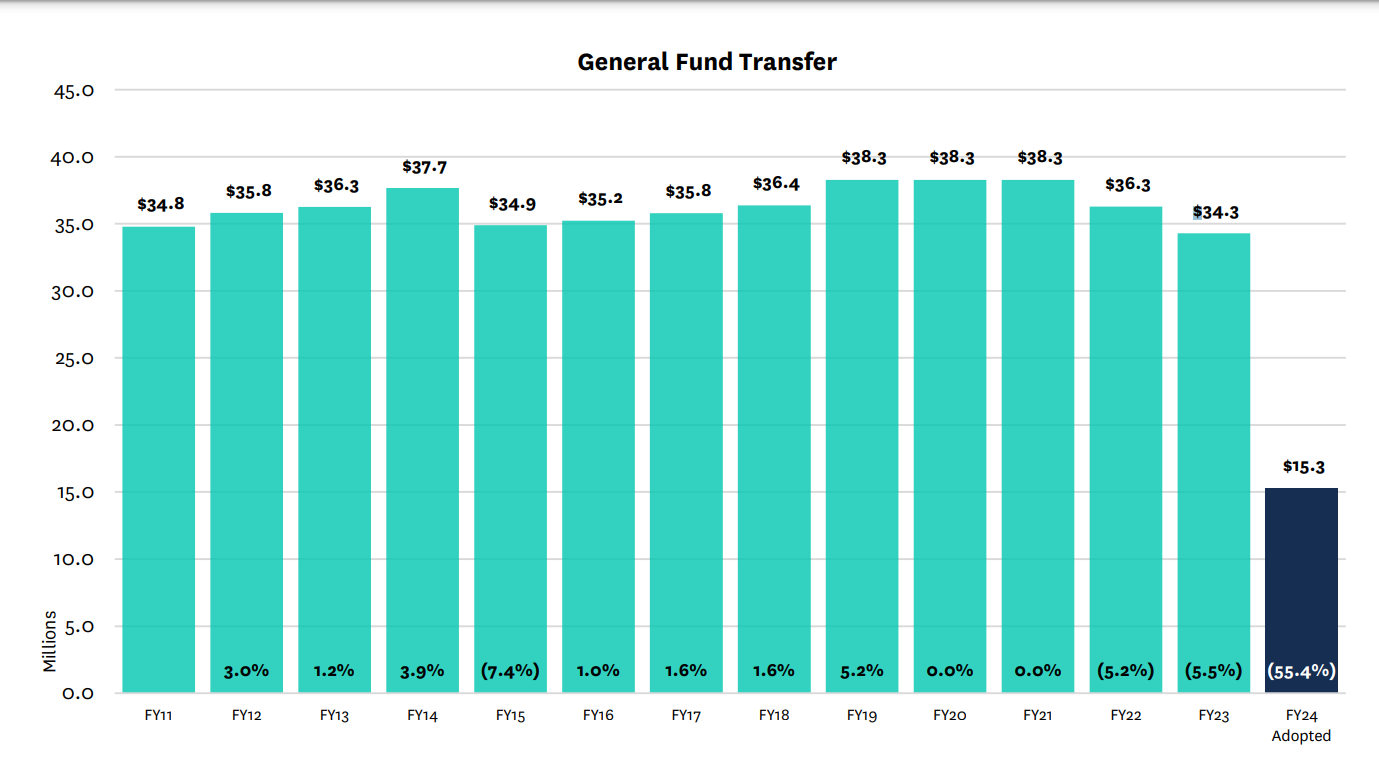
That came out to around $26 million payment-in-lieu-of-taxes with a return-on-investment on $10 million. That seemed reasonable to me. It was reasonable for both Democratic and Republican mayors over the years, who voted for that when they served. And it was reasonable to outside financial consultant nFront Consulting, who in 2021 recommended that amount. When nFront Consulting was hired by GRU to find a number that would keep them financially stable while paying a reasonable fund transfer to the city, they came up with $35 million.
Now, because this transfer is so incredibly low, the owners of the utility are now making zero return on investment, and receiving significantly less in taxes from GRU than if they were a private company. The residents of Gainesville are, essentially, subsidizing GRU to help them pay down their debt faster.

Accounting for the Net Book Value of GRU’s assets in 2022 and tallying what their standard franchise fees would be, GRU should be paying the City of Gainesville around $25 million in taxes a year, and the County, School Board, LIbrary District etc. an additional $35 million. That’s $60 million GRU has not had to pay as a tax-exempt entity (5).
That’s a big deal. It means we are undervaluing our utility by millions of dollars. That isn’t sustainable. It isn’t sustainable for the City and it isn’t sustainable for GRU either.
Cutting the fund transfer will not help your bills
According to a presentation that GRU gave the GRU Authority in early December, the General Funds Transfer makes up $5.21 of your GRU bill a month, so reducing it would reduce your GRU electric bill by about 3.3% at the standard 1,000 KWh level (6). Just to put that into perspective, GRU electric bills have dropped $26.89 per month since January, or 14.7%. So yes you could see a decrease, but it would pale in comparison to what happened earlier this year (7).
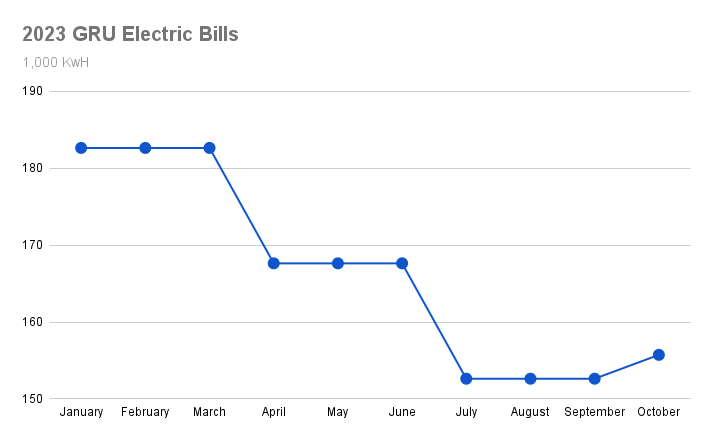
And even then, if we made up for that GRU electric rate reduction with tax increases it would cost City residents a lot more. For every $.89 reduction in GRU electric rates a resident with a home worth $200,000 will need to pay $1.49 in additional taxes just to even that out (8). That’s a bad deal.
But the reality is they are very unlikely to reduce GRU rates even with this reduction, and that’s for good reason. The ratings agencies have been promised by successive commissions that we will continue to keep pace with inflation with our GRU rates.
Following the takeover of GRU by the Governor, S&P came out with their analysis of our bond ratings. We were lucky, they kept our bond ratings stable at an “A”, but expressed a lot of reservations about this new board. Particularly questioning if they would be willing to raise GRU rates to reach the rate of inflation.
Although we believe that credit quality would be maintained at the current rating level even if GRU's financial metrics fall modestly short of projected levels, it could be compromised if the new board imposes a strategic direction that may result in more substantial erosion, whether because of failure to pass through rising fuel costs or to adopt credit-supportive base rate increases.
If the GRU Authority doesn’t raise base rates it could result in a bond ratings downgrade, regardless of what they do with the funds transfer. If that happens borrowing will go up, and it will make GRU rates higher for the foreseeable future.
Cutting the transfer hurts GRU too
If there’s one thing GRU needs right now it’s stability. GRU has been taken through the wringer, its reputation dragged through the mud for political benefit and is now in completely uncharted territory.
GRU is now the only municipal utility in the nation that is appointed by the Governor of the state. It is the only utility with no accountability to the local electorate or oversight from a state public service commission. It is the only merged local/state utility in the country. The portion of our charter that stands it up is oddly written, contradictory, and messy.
Unsurprisingly, the bond ratings agencies are on high alert after this governance change, and to them good governance and stability is infinitely more important than debt.
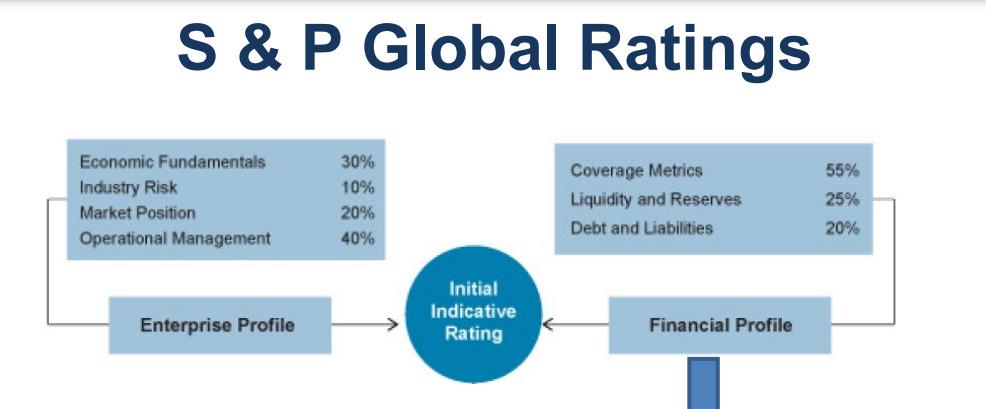
Here is S&P’s framework for how they rate municipal utilities. As you can see from the chart above, to them debt is important, but it’s the least important part of their financial analysis. Having the money to make the debt service payments is significantly more important, and GRU has that in spades. That’s true for the other ratings agencies too, which explains why we have such high bond ratings despite having high debt.
Much more important to them than debt is operational management, being in good standing in the market, and having a strong economy to exist within. All of these more important metrics are imperiled by throwing caution to the wind and becoming the only municipal utility without a funds transfer.
GRU is merely five “enterprise funds” of the City of Gainesville. Their employees are city employees, hired by human resources, with buildings on city owned land. GRU needs General Government to be well functioning if it wants to be well functioning. Forcing layoffs in human resources, equal opportunity, or legal will hurt them too.
GRU is reliant on the economic growth of the City of Gainesville for its customer growth, which its entire business is predicated on. A city that can’t respond to crimes because of laid off police officers, is slow to answer fire requests, or one filled with homeless residents recently booted out of the city funded homeless shelter isn’t a city that’s growing economically, and that means the utility isn’t growing.
GRU is reliant on good relationships and partnerships, like all businesses are. In their first year in power forcing shutdowns of beloved institutions like GRACE Marketplace, layoffs of first responders, and increasing resident’s taxes isn’t an organization building goodwill and partnerships.
This doesn’t have to be zero-sum
One core belief I have is that public policy doesn’t have to be zero-sum. You don’t have to lose for me to win. There are almost always ways to find solutions that benefit everyone, or at least don’t decimate one side to the benefit of another.
This new governor-appointed board is going to have to decide what they want to do: build bridges or burn them. Building bridges means creating a GRU that is rebuilding trust with a customer base that is wary of these changes. Building bridges means understanding that GRU isn’t an island, it’s a utility based in the organization of the City of Gainesville that does business with the businesses and residents of that City. Building bridges means making hard business decisions inward, not constantly going back to the taxpayers to shoulder that burden.
The GRU Authority Board likes to talk about running GRU like a business, but I know how a business would be run: they would be paying their full taxes, they would be trying to build goodwill with the community, and they would be trying to build partnerships to ensure a stable business into the future after a divisive transition.
Whether they do that remains to be seen. I guess we’ll find out in January.
- These are just my numbers and I kept it simple. These won’t be the final cut numbers, this is just an exercise to show what a clean, fair, even cut across the board would look like. The City Manager’s office has their own internal numbers that include both negotiated wage increases, growth in the taxable value of properties, new properties on the rolls, and removing non-discretionary funds. Using their more complicated system the numbers come out about the same, if not a bit worse than I laid out here.
- Police is $41 million, Fire Rescue $28 million, non-departmental $32 million, Public Works $17 million, Parks Recreation & Cultural Affairs $12 million. All from the 2024 budget document.
- This is based on the “Net Revenues as Per the Bond Resolution” that is now in our Charter. You can also see it in the budget for GRU for 2024, which “excess debt payments” add up to that same $31 million.
- This is only the electric side of the utility because that’s the number GRU staff highlighted at their December 6th meeting, but taking the whole transfer into account and comparing it across utilities you get about the same thing.
- These are just my numbers, but it should be noted that this has been analyzed over the years and around $25 million in taxes to the City is common. Most recently nFront Consulting found GRU would be paying $26 million to the City in their 2021 analysis.
- Page 8 of the December 6 GRU Authority presentation, according to the presentation if the entire GFT reduction were applied to electric it would drop by $8.37, but I’m faily sure that’s illegal since it would result in the water system and natural gas system subsidizing the electric system. More likely, it would reduce water, natural gas and electric bills by small amounts each, but how much that is I don’t know. It wouldn’t be $8.37.
- This is based on the Florida Municipal Electric Association’s Electric Bill Comparisons, which is a great resource to compare GRU electric rates to other utilities across Florida.
- This is a cited from former GRU General Manager Ed Bielarksi, which I link above. I’m not sure where he gets that number from, but in 2021 general government did a similar analysis and found wide disparities between the increase in taxes City Residents would be paying vs the electric reduction. For some houses it’s like 3 times as much, other it’s only 1.5 times, but it’s always a lot more.
You can read more of LWV of Alachua County's actions and updates on the GRU controversy in our Article and Action Alert.